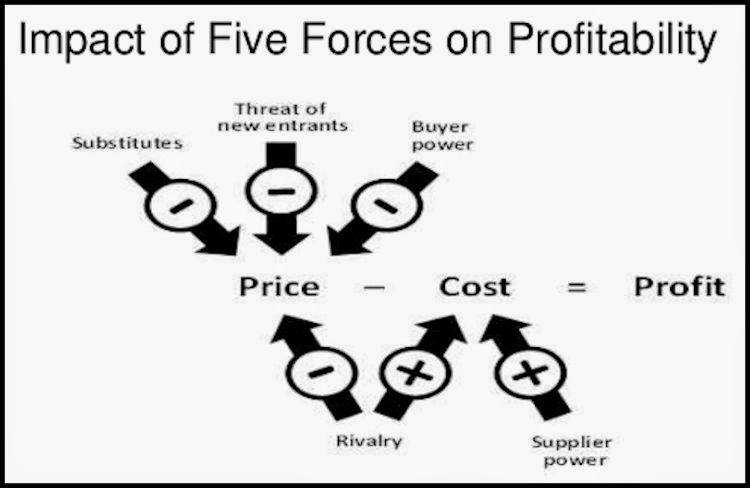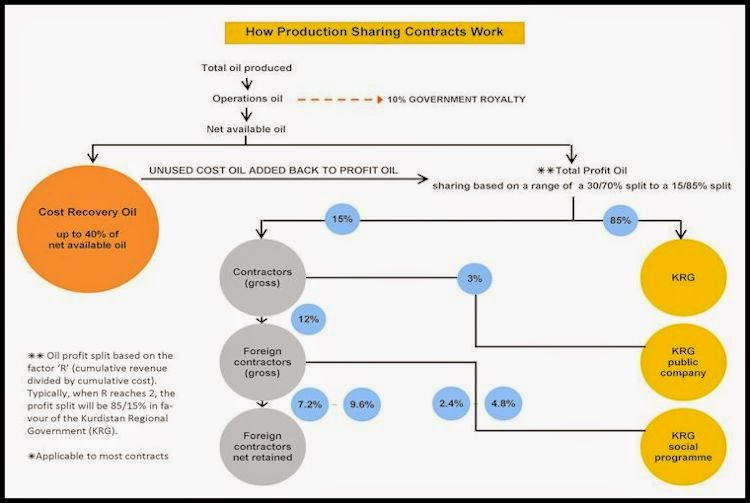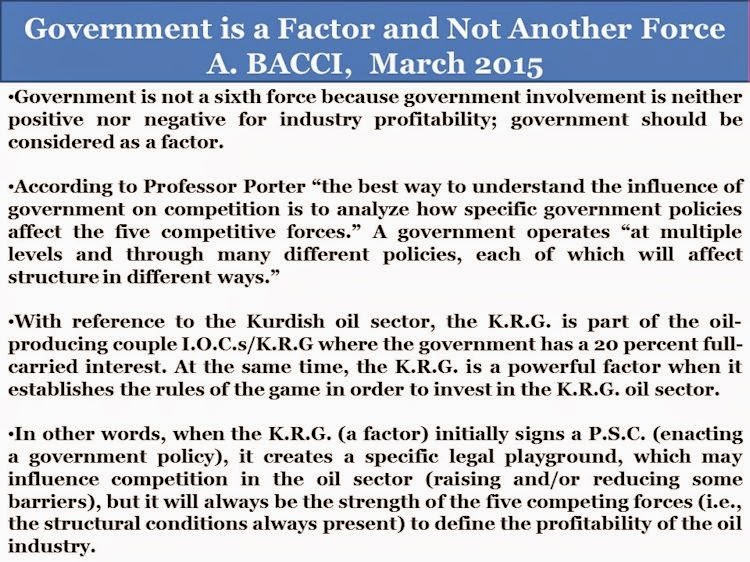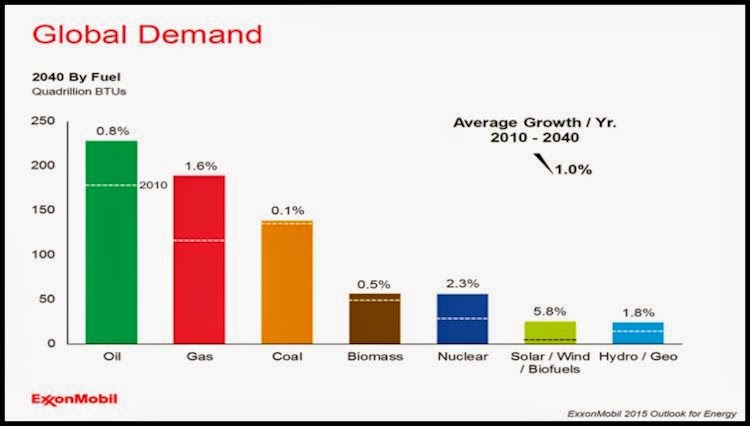March 29, 2015
BEIRUT,
Lebanon
ABSTRACT
This
essay is the direct consequence of a request for advice that I have recently received
from a European broker who wanted to better understand the structure of the upstream oil
industry of the Kurdistan Regional Government (K.R.G.). After an initial
preamble recounting the difficulties that the broker experienced, the paper
applies the five forces analysis to the K.R.G. upstream oil sector. The five forces
analysis, developed by Professor Michael Porter of Harvard University, is one
of the most powerful business frameworks in order to understand the structure
of whatever industrial sector, upstream oil sector included. This essay is
strongly indebted to the book "Understanding Michael Porter" by Joan Magretta and the paper "The Five Competitive Forces That Shape Strategy" by Michael Porter.
PREAMBLE
Approximately
a month ago, a European commodities broker wanted my advice in relation to a
possible deal that he was negotiating with reference to oil from the Kurdistan
Regional Government (K.R.G.). In an initial phase, this broker and his team had
negotiated with some local Kurdish intermediaries in order to have a meeting at
the K.R.G. Ministry of Natural Resources (M.N.R.), but later they were not very
satisfied with the result. In fact, when they had gone to Erbil they had discovered
that they did not have any direct access to the M.N.R. and that those people they
were dealing with were probably simple wheeler-dealers offering crude oil with
a paltry discount — just around $2, with a commission fee of $1; at the
beginning the talks had revolved around a possible discount of $8 to $10 with
reference to Dubai Crude (A.P.I. gravity of 31 degrees and 2 percent sulfur content). So, the negotiations were interrupted. Later, when I was contacted, the
broker told me that he was negotiating a medium light from Khurmala (with
A.P.I. gravity of 34 degrees) with a $5 to $6 discount and a free on board (F.O.B.) delivery
at Ceyhan, Turkey. In specific, he was looking for 2 million barrels of crude
oil every month. With no doubt an important quantity. Also these negotiations
did not end well because the Kurds after a while replied that at least for the
coming six months they would not have any available free quantity of crude oil
to sell.
This
reply could make sense in light of the current difficult implementation of the
December 2014 oil deal between Erbil and Baghdad. This agreement established
that the K.R.G. should export 250,000 barrels per day of
its own oil and 300,000 barrels per day from the Kirkuk fields that the K.R.G. currently
controls — 550,000 bbl/d in total (for more information please see: BACCI, A., The Iraqi-Kurdish Oil Deal, December 2014). But, already last December when it was
discussed, the deal appeared very shaky; and since then both sides have
presented different numbers in relation to the oil currently exported by the
K.R.G.; indeed, as a consequence of this confusion, it's not easy to find an acceptable compromise. The federal
government affirms that the K.R.G. is presently delivering only 135,000 bbl/d
to Iraq's central State Organization for Marketing Oil (SOMO), while Erbil
responds that it is delivering approximately 400,000 bbl/d, which is the
highest production it can reach at the moment. Kurdish sources affirm that by
the end of April the K.R.G. will be able to export 625,000 bbl/d. At the same
time, the
Iraqi federal government has not been able to hold up its side of the deal. In
fact, Baghdad sent to Erbil a first payment of around US$200
million at the beginning of March and then around mid-March a $420million budget payment. The problem is that it is still short of its December
2014 commitments. In any case, in light of the relevant quantity requested, I
immediately suggested that the broker and his team have contact only and
exclusively with the Ministry of Natural Resources. The daily production of
Iraqi Kurdistan is currently 400,000 bbl/d, i.e., around 12 million bbl/m, so a
monthly request of two million barrels means one-sixth of the overall Kurdish
production in a month. Moreover, in order to have some additional information
on the part of the international oil companies (I.O.C.s) working in Iraqi
Kurdistan, I contacted Genel Energy, an Anglo-Turkish company, which is the
most important producer of crude oil in the K.R.G — it is the lead foreign
partner in the development of the Taq Taq field (A.P.I. gravity of 48 degrees) whose
production capacity is 130,000 bbl/d according to the U.S. Energy Information Administration (E.I.A., January 2015). Head of Public Relations, Andrew Benbow,
rightly confirmed me by e-mail that as
Genel Energy passed on its oil at the wellhead and the K.R.G. was the exporter,
it was the K.R.G. that a buyer needed to contact.
THE IDEA BEHIND THIS ANALYSIS
The
basic idea of this analysis is to define the industry structure of the K.R.G.
oil sector according to Michael Porter's five forces framework. As Professor
Porter points out "the real point of competition is not to beat your
rivals. It's to earn profits." And, according to the story I have
presented in the previous paragraphs, it has clearly emerged that an evaluation of the K.R.G. oil sector could be very helpful in order to understand how to work in Iraqi Kurdistan.
The perspective of this analysis is centered on the couple I.O.C.s/K.R.G., which is to be considered as the "oil-producing entity". In Iraqi Kurdistan, I.O.C.s and the K.R.G. are linked through a production sharing contract (P.S.C.). Under a P.S.C. the contractor makes risk investments and provides technical and management services in return for a share of production to recover its costs (“Cost Oil”) and a share of the remaining oil (“Profit Oil”) as its profit. The contractor has the right to market its share of oil and "book" the reserves. In the production phase, however, the government of the hosting country may take a direct stake in the project. In general, the extent of the government's participation varies from less than 30 percent to as much as 70 percent. As a consequence, the government shares "rewards and technical, price, and operating cost risks with the I.O.C. in proportion to itsshare in the project" (Maurer - Tarontsi, 2009). In addition, the government collects taxes and royalty payments.
 |
| Elements of Industry Structure — Source: Wikipedia |
The perspective of this analysis is centered on the couple I.O.C.s/K.R.G., which is to be considered as the "oil-producing entity". In Iraqi Kurdistan, I.O.C.s and the K.R.G. are linked through a production sharing contract (P.S.C.). Under a P.S.C. the contractor makes risk investments and provides technical and management services in return for a share of production to recover its costs (“Cost Oil”) and a share of the remaining oil (“Profit Oil”) as its profit. The contractor has the right to market its share of oil and "book" the reserves. In the production phase, however, the government of the hosting country may take a direct stake in the project. In general, the extent of the government's participation varies from less than 30 percent to as much as 70 percent. As a consequence, the government shares "rewards and technical, price, and operating cost risks with the I.O.C. in proportion to itsshare in the project" (Maurer - Tarontsi, 2009). In addition, the government collects taxes and royalty payments.
According
to Paragraph 1 under the title "Government Interest" of Article 4 —
Options of Government Participation and Third Party Participation of the Production Sharing Contract Model of the K.R.G.:
The GOVERNMENT shall have the option of participating through a Public Company in this Contract, in respect of the entire Contract Area, as a CONTRACTOR Entity, with an undivided interest in the Petroleum Operations and all the other rights, duties, obligations and liabilities of the CONTRACTOR (save as provided in and subject to this Article 4) under this Contract in respect of the Contract Area, of up to [ ] per cent ([ ]%), and not less than five per cent (5%) (the “Government Interest”), such option being referred to herein as the “Option of Government Participation”. The GOVERNMENT shall be entitled to exercise the Option of Government Participation by notifying the CONTRACTOR in writing of such election and the size of the Government Interest.
So, according to these considerations,
it makes sense to analyze the industry structure of the K.R.G. through the
perspective of the oil-producing couple I.O.C.s/K.R.G.
The International Energy Agency (I.E.A.) in its Iraq Energy Outlook of November 2012 estimated that Iraqi Kurdistan contained 4 billion barrels of proved
reserves. Instead, the K.R.G. estimates are much higher because they include
unproved resources too. Quite recently the K.R.G. has increased its oil
resources estimate from 45 billion barrels to 60 billion barrels — some
resources are in the areas disputed between Erbil and Baghdad.
 |
| The Kurdistan Region — Source: Petroleum Economist |
 |
| The Kurdistan Region — Source: Petroleum Economist |
On average, in Iraq proper it costs about $5 to produce a barrel of oil; with reference to the K.R.G., we are in the same range. For instance, Genel Energy, one of the operators in Iraqi Kurdistan, has finding and development costs (F&D) less than $3 a barrel and operating expenses (OPEX) less than $2. Tony Hayward of Genel Energy has recently declared that his company could still profitably produce a barrel of oil with oil prices around $20 a barrel. In times of low oil prices, low production costs are a huge advantage for oil-producing countries and the companies technically doing the job. For more information please see: BACCI, A., Why Do I.O.C.s Have to Invest in Iraqi Kurdistan and/or Southern Iraq?, December 2014.
In other words, notwithstanding
the current complex and harsh dispute between Erbil and Baghdad, the
combination of relevant oil reserves and the low production costs has been a
powerful tool capable of attracting to Iraqi Kurdistan in the last years around
fifty international oil companies — initially small and medium companies and
later large ones. Addax Petroleum — at that time a Swiss company, while today
it's a subsidiary of China's Sinopec — and Genel Energy together signed a
P.S.C. related to the Taq Taq field as early as May 2004. Today, also four big
names are investing in Iraqi Kurdistan: U.S. ExxonMobil and Chevron, France's
Total and Russia's Gazprom. For more information please see: BACCI, A., Chevron and Total Continue Investing in the K.R.G. A Brief Analysis of Baghdad's T.S.C.s vs. Erbil's P.S.C.s, June 2013.
Four are the most important oil
fields in the K.R.G.:*
1) Khurmala Dome (Iraqi
Kurdistan's KAR Group, 110,000 bbl/d, A.P.I. gravity of 34 to
25 degrees),
2) Tawke (Norway's D.N.O. and
Genel Energy, 130,000 bbl/d, A.P.I. gravity of 26 to 28
degrees),
3) Taq Taq (Genel Energy and
Sinopec, 130,000 bbl/d, A.P.I. gravity of 47 to 48 degrees) and
4) Shaikan (Gulf Keystone,
21,000 bbl/d, A.P.I. gravity of 18 degrees).
*(Data relative to January 2015)
At the end of January 2015 the
K.R.G. production capacity stood at approximately 400,000 bbl/d, of which
150,000 bbl/d were sold and refined locally within the K.R.G. thanks to the
Kalak refinery, near the capital Erbil, and the Bazian refinery, in Sulaymania Governorate.
 |
| Source:
The Energy Information Administration (January 2015) |
This analysis covers the industry structure of the oil sector in the K.R.G. alone; the fields around the city of Kirkuk are not considered. In fact, notwithstanding that the K.R.G. expanded its control over the Kirkuk area in June 2014, it's not clear what the political future of the city and its governorate will be. The Peshmerga forces blocked the possibility that the city and its precious oil reserves fell into the hands of the Islamic State, but already today, one of the most contentious issues between the federal government and the K.R.G. is the destiny of Kirkuk and its oil riches. In fact, the Kurds strongly insist that the oil-rich city of Kirkuk and the surrounding areas be included in the K.R.G. For more information please see: BACCI, A., Iraqi Kurdistan's Occupation of Kirkuk Oil Field Will Deeply Affect the Iraqi Oil Sector, June 2014.
THE INDUSTRY STRUCTURE OF THE K.R.G. OIL SECTOR
Joan
Magretta of the Institute for Strategy and Competitiveness at Harvard Business School correctly explains that "competition is the tug-of-war over profits
that occurs not just between rivals but also between a company and its
customers, its suppliers, makers of substitutes, and potential new
entrants." In other words, it's meaningless to compete in order to be the
best for the simple reason that there are many ways to serve customers, who
indeed may have very different necessities. In sports it may make sense to
speak about "competing in order to be the best"; unquestionably on
February 1, 2015, the New England Patriots won the XLIX Super Bowl defeating
the Seahawks 28-24. But, in the business arena "competition is more complex,
more open ended and multidimensional. Within an industry, there can be multiple
contests, not just one, based on which customers and needs are to be
served." So the real competition relates to competing for
"profits", which derive from the following equation:
PROFITS
= PRICE - COST
And
this concept is absolutely true in relation to every single P.S.C. that the
K.R.G. has signed in the last years with an I.O.C. Both, the government and the
I.O.C., work with the goal of doing profits not with the goal of being the
best.
So
the industry structure determines profitability. One of the most complete
frameworks in order to assess competition in any industry is the analysis of the
industry's structure according to Porter's five forces.
 |
| Source: "Understanding Michael Porter" by Joan Magretta |
 |
| Source:
"Understanding Michael Porter" by Joan Magretta |
 |
| Porter’s Five Forces Model of Competition — Source: MAX 360 @AIGROUP |
The Threat of New Entrants (Low)
"The
threat of entry in an industry depends on the height of the entry barriers that
are present and on the reaction entrants can expect from incumbents"
(Porter 1998).
In
relation to the oil sector, and this is completely applicable to the K.R.G.
upstream oil sector, these are today's main entry barriers:
1)
Supply-side economies of scale
If
an oil contract equitably balances the interests of the involved I.O.C.s and
the host country, oil firms producing at larger volumes normally enjoy lower
costs per unit because they are able to spread their fixed costs over more
units (barrels), they employ more efficient technology or negotiate better
terms with equipment suppliers and/or subcontractors. In fact, CAPEX are
practically the same if from a reservoir we extract 100 bbl/d or 100,000 bbl/d,
but, of course, the more barrels we extract the lower it is their marginal
cost. The Kurdish P.S.C.s well align the interests of the investors and the government; both want to find large and low costs oil fields (van Meurs, 2008). In this regard,
it should be noted that in the oil business many a time there are contracts (quite
often with Service Contracts) where there is no real incentive for the
investors to find large low cost fields.
2)
Capital requirements
The
oil sector is a capital intensive business. A company starts spending important
economic resources immediately after the signature of an oil contract — no
matter what type of contract it has signed. And new oil projects have long time
horizons before permitting to recoup some of the investments. So, in light of
their reduced cash availability, small companies (the so-called wildcatters)
and midsized companies need to have a short timeframe between the exploration
phase and the production phase. If these companies do not get stable and continual
payments, they risk a bankruptcy. Current developments in the K.R.G. show that
the three midsized companies that are already producing crude oil, Genel
Energy, D.N.O. and Gulf Keystone are all experiencing economic troubles because
they have not received stable and continual payments from the K.R.G.; only Genel
Energy has a better financial position because last year it did a bond issue
through which it raised $500 million, and because in addition to it, the company has recently
completed the private placing of $230 million of bonds.
3)
Restrictive government policy
As
a consequence of the nationalizations of the 1970s in the Middle East the oil
sector has a widely restricted access — still today Saudi Arabia's oil sector
is completely sealed off for foreign companies (although not the non-associated
gas sector). Oil belongs to the host country and, in general, if an I.O.C.
wants to sign a deal, it has to participate in a bidding process or to
negotiate directly with the host country, which will decide all the contractual
terms. In a country there could be parts of territory where there are proven,
probable or possible reserves, but without a contract there will be no access
to them. In the K.R.G. any company interested in developing an oil field needs
to sign a very detailed P.S.C. with the regional government. Erbil has
developed a production sharing contract model, and every signed contract is
based on this model. The decision of using P.S.C.s has been strongly criticized
and opposed by the federal government, which has always favored technical
service contracts (T.S.C.), which it signs after an auction.
"Powerful suppliers capture more
of the value for themselves by charging higher prices, limiting quality or
services, or shifting costs to industry participants. Powerful suppliers,
including suppliers of labor, can squeeze profitability out of an industry that
is unable to pass on cost increases in its own prices" (Porter, 1998).
The K.R.G. oil sector with reference to the power of
suppliers follows the general trend present in the oil and gas industry: a
balanced relation between suppliers and oil companies. In fact, it's true that
many international oil companies are vertically integrated, but it is also true
that, with reference to the specific tasks they have to implement, they utilize
many different subcontractors. And, in general, there is a sort of one-to-one relation
between suppliers and oil companies: The latter need the specific skills of the
former, but, at the same time, the suppliers depend heavily on the oil industry
for their revenues because they are not able to serve different industries. There
is no doubt that industry participants face switching costs in
changing suppliers, that suppliers offer products that are differentiated and
that there is no substitute for what the supplier group provides, but, in light
of the high specialization (tailor-made services) of the provided services, the
suppliers do not have many alternative buyers. Only in recent years, the power
of suppliers has partially augmented because some supplier groups have
succeeded in integrate forward into the industry so that they have managed
projects previously operated exclusively by an I.O.C.
The Power of Buyers (Final Buyers Low — Direct Buyers Medium)
"Powerful customers—the flip side of powerful
suppliers—can capture more value by forcing down prices, demanding better
quality or more service (thereby driving up costs), and generally playing
industry participants off against one another, all at the expense of industry
profitability. Buyers are powerful if they have negotiating leverage relative
to industry participants, especially if they are price sensitive, using their
clout primarily to pressure price reductions" (Porter 1998).
In the oil business, market demand is a primary
factor in setting prices, but it is important to differentiate between the
buyers of crude oil in the physical market and buyers of refined
products (for instance, gasoline). In fact, the individual purchaser of refined
products, who is also the final consumer of the transformed crude oil, is an individual with low
bargaining powers. For instance, if a driver needs to use his car, he will
always pay the price per gallon as indicated on the billboard at the gas
station. He will complain that prices are high, but he will not have any
tangible power to lower them.
Instead, when analyzing the structure of the oil
industry in a specific area (be it a country, a region or a province) it is
probable more useful to focus our attention on the direct buyers, who are
most often refiners who process the crude oil into the various petroleum
products for commercial and retail customers, or international traders. Most
refining capacity in the world is owned and operated by the larger integrated
companies, the N.O.C.s and, recently also by independent refining sector
companies.
Direct buyers have a relevant negotiating power
because:
1) They are not many and because they purchase in
volume that are large relative to the size of the vendor.
2) The industry's products are standardized or
undifferentiated. Many a time crude oil exports from a specific country are a
single blend of all the crude types present in that country. In general,
refineries are not able to process all the types of blend present on the
market, but still on the market they can purchase alternative blends satisfying
the requirements of their processing plants.
3) Buyers face few switching costs in changing
vendors. Although there are different blends, oil is a commodity.
With reference to the K.R.G. there are two different
types of direct buyers: Turkey's refiners (for instance, Tüpraş), and
international traders and refiners (these may be integrated in an oil company
or independent too).
It is important to focus our
attention on Turkey because this country is not only a significant oil
consumer in its own right, but it is also a natural energy hub between three
major oil-producing areas (Russia, the Caspian Sea basin and the Middle East)
and the European consumer markets. Moreover, Ceyhan is a port that is able to
accommodate very large crude carriers (V.L.C.C.) and ultra large crude carriers
(U.L.C.C.).
According
to the U.S. Energy Information Administration (E.I.A.):
In 2013, Turkey's total liquid fuels consumption averaged 734,800 bbl/d. More than 90% of crude oil consumption and significant quantities of petroleum products came from imports. According to the IEA [International Energy Agency], Turkey's crude oil imports are expected to double over the next decade. In 2012, the majority of Turkey's crude oil imports came from Iran, which supplied 35% of the country's crude oil. Russia, once the largest source country of Turkey's crude oil, has fallen behind Middle East suppliers in terms of volume and is now the fourth-largest supplier of crude oil to Turkey.
There
is a strong economic complementarity between Iraqi Kurdistan and Turkey. The
latter needs the K.R.G. crude oil (and gas too), while Iraqi Kurdistan needs
the revenues obtained from selling oil to Turkey. In practice, an oil trade
between the K.R.G. and Turkey is a win-win solution for both sides — although for
the K.R.G. it would not be advisable to have an important dependence on a
single buyer. For more information please see: BACCI, A., Why Do I.O.C.s Have to Invest in Iraqi Kurdistan and/or Southern Iraq? February 2015.
After
years of flat markets, falling profits and declining margins, international oil
traders (for instance, Glencore, Gunvor, Mercuria, Trafigura and Vitol) are
currently experiencing very favorable conditions since the global financial
crisis of 2008. The rise in oil volatility is helping the traders to obtain
improved margins in their transactions —more arbitrage. The current slide in crude oil since mid-June 2104 has also provided an important boost to the profit margins for the ailing European refining industry, which struggled to turn a profit when crude oil remained at or around $100 a barrel.
It
is worth remembering that international refiners and traders are price
sensitive because:
1)
The oil they buy represents a significant fraction of their cost structure or
procurement budget.
2)
In general they have low margins and/or are under pressure to trim their purchasing
costs.
3)
The quality of services they provide is little affected by the industry's product.
4)
Crude oil has little effect on the buyer's other costs.
All
these elements, which are completely valid also for the refiners and traders
working with the K.R.G. oil, explain that oil refiners and oil traders have a certain
negotiating leverage relative to the K.R.G. This is exactly what happened with
the broker who contacted me. He was not satisfied with the terms obtained from
the K.R.G. and he walked away without a deal because he knew that he might find
some alternatives: Iraqi Kurdistan exports a blended medium (crude oil quality of 30 to
32 degrees A.P.I. and 2.52 percent sulfur content) that is very similar to the Kuwaiti
blended medium (crude oil quality of 31.4 degrees A.P.I. and 2.52 percent
sulfur content).
In
addition, low international oil prices (Brent, the widely used international reference, is at $57 per barrel when
last June it was around $115) and the strong confrontation between Erbil and
Baghdad with reference to the exports of Kurdish oil from the K.R.G. (a high
political risk) are two elements (two external factors, not two forces) that
reduce the power of the oil producers versus the buyers. An oversupply of crude
oil reduces the prices that the K.R.G. may ask for and at the same time if the
buyer may experience a possible lawsuit after purchasing crude oil from the
K.R.G., he will necessarily request an important discount — we apply the same
logic of the bond market: a higher risk requires a higher reward; the only
different is that with bonds there is a higher interest rate and with
quantities of crude oil an initial discount.
The Threat of Substitutes (Low)
"A substitute performs the same or a similar
function as an industry’s product by a different means" (Porter 2008).
Oil is primarily used as a
transportation fuel. According to ExxonMobil "oil is expected to remain the No. 1 energy source and demand will increase by nearly 30 percent, driven by expanding needs for transportation and chemicals". In other words, it is difficult to imagine a real alternative
(from renewable energy sources, nuclear power or other fossil fuels) to oil in
the transportation business in the coming years. Moreover, there will be an
overall increase in the consumption of crude oil in the transportation sector
in the coming decades.
"Rivalry among existing competitors takes many
familiar forms, including price discounting, new product introductions,
advertising campaigns, and service improvements. High rivalry limits the
profitability of an industry. The degree to which rivalry drives down an
industry’s profit potential depends, first, on the intensity with which companies compete
and, second, on the basis
on which they compete"
(Porter 2008).
Rivalry
in the upstream oil business is quite high for the following considerations:
1)
There are many competitors.
2)
Industry growth is slow.
3)
Exit barriers are very high.
4)
Rivals are highly committed to the business and have aspirations for leadership.
5)
The involved actors have a different approach to competing.
In
general, "rivalry is especially destructive to profitability if it
gravitates solely to price because price competition transfer profits directly
from an industry to its customers" (Porter 2008). This occurs when:
1)
Products or services of rivals are nearly identical and there are few switching
costs for buyers.
2)
Fixed costs are high and marginal costs are low.
3)
Capacity must be expanded in large increments to be efficient — with possible
oversupply.
4)
The product is perishable (this does not happen with crude oil)
Apart
from the fourth point, which has no relation with crude oil, the three initial points
should be able to force a real price competition capable of transferring
profits to customers. This is exactly what has occurred in the last months when
consumers around the world have enjoyed reduced prices at the pump. Oil supply
and oil demand determine the price of oil, but many times some external
factors, like wars, sanctions and cartels, may contribute to cancel the
availability of some reserves from the world map. The result is that, notwithstanding
the high rivalry in the upstream oil sector among the involved players, it is
not automatic that profits are transferred to direct buyers and then to
consumers. Currently, this profits transfer is occurring because the increase
of the U.S. production of unconventional oil has permitted a considerable
reduction in the price of a barrel of oil.
The
I.O.C.s/K.R.G. entities working in Iraqi Kurdistan face an important rivalry at
the world level because it is there that they really compete — this is their
geographical scope. In fact, only a
reduced quantity of the Kurdish crude oil production, around a quarter, is sold
domestically in Iraqi Kurdistan with a price significantly cheaper than the
international market price. In specific, the various I.O.C.s/K.R.G. entities pass
on their crude oil at the wellhead and then Kurdish Oil Marketing Organization
(KOMO) or State Oil Marketing Organization (SOMO) of Iraq proper — the export
channel is an important friction point between Erbil and Baghdad — sells
approximately three-quarters of the Kurdish crude oil production (the lion's
share of the production) abroad, on the world markets, via the Kirkuk-Ceyhan
pipeline. The Kurds have built two pipelines that enter the Kirkuk-Ceyhan
pipeline at Fishkhabur because the section from Kirkuk to Fishkhabur has been
out of service since March 2014 as a consequence of repeated militant attacks.
In fact, the Iraqi section of the Kirkuk-Ceyhan pipeline runs through Islamic
State-controlled territory. So, Kurdish oil necessarily competes with the
production of several different countries, which may have crude oils with
characteristic very similar to the Kurdish one.








No comments:
Post a Comment
Note: Only a member of this blog may post a comment.